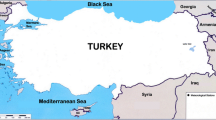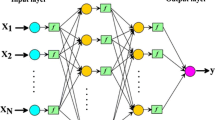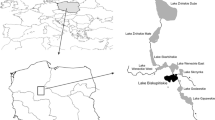Abstract
Understanding and forecasting water level fluctuations in Lake Michigan-Huron is important for a variety of water resource management operations such as flood control, local water supply management, shoreline maintenance, ecosystem sustainability, recreation, and economic development. In this study, wavelet transform, fuzzy logic and multilayer perceptron techniques are combined to obtain new approaches for forecasting lake level fluctuation. The wavelet approach is used to decompose water level time series into its spectral bands. Predictive models have been developed as stand-alone fuzzy logic, stand-alone multilayer perceptron combined wavelet-fuzzy and combined wavelet-multilayer perceptron models in order to forecast the water level fluctuations. The models were tested to predict the current water level (at t monthly time step) and lead times including t + 3, t + 6, t + 9 and t + 12 time steps from the water levels at two previous time steps (t − 2 and t − 1). In this study, the historic water level data was obtained from Lake Michigan-Huron for the period between 1855 and 2006. For the model development, monthly water level data was divided into two groups. The training group consists of the data for the first 101 years (from 1855 to 1955) with 1212 data points, which were, then, used to predict the water levels for remaining 51 years (from 1956 to 2006). The results reveal that all the four models can predict the water levels quite accurately. In comparison, the combined wavelet-fuzzy logic and combined wavelet-multilayer perceptron models outperformed the stand-alone fuzzy and multilayer perceptron models for lead times of 1, 3, 6, 9 and 12 months. This comparison was performed based on the root mean squared error (RMSE), the coefficient of efficiency (CE), the mean absolute deviation (MAD) and the skill score (SS) between observed data and prediction results.












Similar content being viewed by others
References
Abrahart RJ, Kneale PE, See LM (2004) Neural networks for hydrological modeling. Balkema Publishers, London
Altunkaynak A (2007) Forecasting surface water level fluctuations of Lake Van by artificial neural networks. Water Resour Manag 21:399–408
Altunkaynak A (2009) Sediment load prediction by genetic algorithms. Adv Eng Softw 40:928–934
Altunkaynak A (2010) A predictive model for well loss using fuzzy logic approach. Hydrol Proced 24:2400–2404
Altunkaynak A (2013) Prediction of significant wave height using geno-multilayer perceptron. Ocean Eng 58:144–153
Altunkaynak A, Şen Z (2007) Fuzzy logic model of water level fluctuations in Lake Van, Turkey. Theor Appl Climatol 90:227–233
Altunkaynak A, Strom KB (2009) A predictive model for reach scale morphology classification in mountain streams using multilayer perceptron methods. Water Resour Res 45, W12502. doi:10.1029/2009WR008055
Altunkaynak A, Özger M, Çakmakçı M (2005) Water consumption prediction of Istanbul city by using fuzzy logic approach. Water Resour Manag 19:641–654
Alvisi S, Marcellani G, Franchini K, Bardossy A (2006) Water level forecasting through fuzzy logic and artificial neural network approaches. Hydrol Earth Syst Sci 10:1–17
Argyilan EP, Forman SL (2003) Lake level response to seasonal climatic variability in the Lake Michigan-Huron system from 1920 to 1995. J Great Lakes Res 29:488–500
ASCE Task Committe on Application of Artificial Neural Networks in Hydrology (2000) Artificial neural networks in hydrology II. Hydrologic applications. J Hydrol Eng 5:124–137
Assel RA, Quinn FH, Sellinger CE (2004) Hydro-climatic factors in the recent record drop in Laurential Great Lakes water levels. Bull Am Meteorol Soc 85:1143–1151
Baedke SJ, Thompson TA (2000) A 4,700-year record of lake level and isostasy for Lake Michigan. J Great Lakes Res 26:416–426
Bardossy A, Duckstein L (1995) Fuzzy-rule based modeling with application to geophysical, biological and engineering systems. CRC Press, Boca Raton
Bardossy A, Mascellani G, Franchini M (2006) Fuzzy unit hydrograph. Water Resour Res 42, W02401
Bishop CT (1990) Historical variation of water levels in lakes Erie and Michigan-Huron. J Great Lakes Res 16:405–425
Bogardi I, Bardossy A, Duckstein L, Pongracz R (2003) Fuzzy logic in hydrology and water resources. In: Demicco R, Klir G (eds) Fuzzy logic in geology. Elsevier, Amsterdam, pp 153–190
Booth RK, Jackson ST, Thompson TA (2002) Paleo-ecology of a northern Michigan lake and the relationship among climate, vegetation, and Great Lakes water levels. Quater Res 58:120–130
Brinkman WAR (2000) Causes of variability in monthly Great Lakes water supply and lake levels. Clim Res 15:151–160
Campolo M, Soldati A, Andreussi P (1999) Forecasting river flow rate during low-flow periods using neural networks. Water Resour Res 35:1191–1197
Cengiz TM (2011) Periodic structures of great lakes levels using wavelet analysis. J Hyrol Hydromech 59(1):24–35
Chang FJ, Chang YT (2006) Adaptive neuro-fuzzy inference system for prediction of water level in reservoir. Adv Water Resour 29:1–10
Chang IC, Chang FJ, Tsai YH (2005) Fuzzy examplar-based inference system for flood forecasting. Water Resour Res 41:W02005
Changnon SA (1987) Climate fluctuations and record high levels of Lake Michigan. Bull Am Meteorol Soc 68:1394–1402
Changnon SA (2004) Temporal behavior of levels of Great Lakes and climate variability. J Great Lakes Res 30:184–200
Chen YW, Chang LC, Huang CW, Chu HJ (2013) Applying genetic algorithm to the conjunctive use of and subsurface water. Water Resour Manag 27:4731–4757
Cobaner M (2013) Reference evapotranspiration based on Class A pan evaporation via wavelet regression technique. Irrig Sci 31:119–134
Cohn BP, Robinson JE (1976) A forecast model for Great Lakes water levels. J Geol 84:455–465
Coops H, Beklioglu M, Crisman TL (2003) The role of water level fluctuations in lakes and wetlands—introduction. Hydrobiologia 539:189–204
Daliakopoulos IN, Coulibaly P, Tsanis IK (2005) Groundwater level forecasting using artificial neural netwrorks. J Hydrol 309:229–240
Dawson CW, Wilby RL (2001) Hydrological modeling using artificial neural networks. Prog Phys Geogr 25:80–108
DeCooke BG, Meregian E (1967) Forecasting the levels of the Great Lakes. Water Resour Res 3:397–403
Desalegn CE, Babel MS (2011) Application of ANN-based streamflow forecasting model for agricultural water management in the Awash River Basin, Ethiopia. Water Resour Manag 25:1759–1773
Firat M, Gungor M (2008) Hydrological time series modeling using neuro-fuzzy inference system. Hydrol Proced 22:2122–2132
Ghanbari RN, Bravo HR (2008) Coherence between atmospheric teleconnections, Great Lakes water levels and regional climate. Adv Water Resour 31:1284–1298
Goldberg DE (1989) Genetic algorithms in search optimization and machine learning. Addison-Wesley, Reading
Govindaraju RS, Rao AR (eds) (2000) ARTIFICIAl neural networks in hydrology. Kluwer Academic Publishers, London
Harnahan JL, Kravtsov SV, Roebber PJ (2009) Quasi-periodic decadal cycles in levels of lakes Michigan and Huron. J Great Lakes Res 35:30–35
Hartmann HC (1990) Climate chnage impacts on Laurential Great Lakes levels. Clim Change 17:49–67
Hartmann H, Becker S, King L (2007) Predicting summer rainfall in the Yangtze river basin using neural networks. Int J Climatol 28:925–936
Hatiboglu MA, Altunkaynak A, Özger M, Iplikcioglu AC, Coşar M, Turgut N (2010) A predictive tool by fuzzy logic for outcome of patients with intracranial aneurysm. Expert Syst Appl 37:1043–1049
Haykin S (1994) Neural networks: a comprehensive introduction. Prentice Hall, New Jersey
Irvine KA, Eberthardt AK (1992) Multiplicative seasonal ARIMA models for Lake Erie and Lake Ontario. Water Resour Bull 28:385–396
Jain A, Kumar AM (2007) Hybrid neural network models for hydrologic time series forecasting. Appl Soft Comput 7:585–592
Katambara Z, Ndiritu J (2009) A fuzzy inference system for modeling streamflow: Case of Letaba River. S Afr Phys Chem Earth 34:688–700
Kim T, Valdes JB (2003) Nonlinear model for drought forecasting based on a conjunction of wavelet transforms and neural networks. J Hydrol Eng 8(6):319–328
Krishna B, Rao YRS, Vijaya T (2008) Modeling groundwater levels in an urban aquifer using artificial neural networks. Hydrol Proced 22:1180–1188
Kucuk M, Kahya E, Cengiz TM, Karaca M (2009) North atlantic oscillation influences on Turkish lake levels. Hydrol Proced 23:893–906
Larson G, Schaetzl R (2001) Origin and evolution of the Great Lakes. J Great Lakes Res 27:518–546
Lee T-L, Makarynskyy O, Shao C-C (2007) A combined harmonic analysis-artificial neural network methodology for tidal predictions. J Coast Res 23(3):764–770
Leira M, Cantonati M (2008) Effects of water level fluctuations in lakes: an annotated bibliography. Dev Hydrobiol 613:171–184
Lliadis LS, Maris F (2007) An artificial neural network model for mountainous water-resources management: The case of Cyprus mountainous watersheds. Environ Model Softw 22:1066–1072
Lofgren BM, Quinn FH, Clites AH, Assel RA, Eberhardt AJ, Luukkonen CL (2002) Evaluation of potential impacts on Great Lakes water resources based on climate scenarios of two GCMs. J Great Lakes Res 28:537–554
Maier HR, Dandy GC (2000) Neural networks for the prediction and forecasting of water resources variables: a review of modeling issues and applications. Environ Model Softw 15:101–124
Makarynskyy O, Makarynska D, Kuhn M, Featherstone WE (2004) Predicting sea level variations with artificial neural networks at Hillary Harbour, Western Australia. Estuar Coast Shelf Sci 61:351–360
Mamdani EH (1974) Application of fuzzy algorithm for control of simple dynamic plant. Proc IEEE 121:1585–1588
May DB, Sivakumar M (2009) Prediction of urban stormwater quality using artificial neural networks. Environ Model Softw 24:296–302
Meadows GA, Meadows LA, Wood WL, Hubert JM, Perlin M (1997) The relationship between Great Lakes water levels, wave energies and shoreline damage. Bull Am Meteorol Soc 78:675–683
Mohanty S, Jha MK, Kumar A, Sudheer KP (2010) Artificial neural network modeling for groundwater level forecasting in a river island of eastern India. Water Resour Manag 24:1845–1865
Mutlu E, Chaubey I, Hexmoor H, Bajwa SG (2008) Comparison of artificial neural network models for hydrologic applications in an agricultural watershed. Hydrol Proced 22:5097–5106
Nayak PC, Sudheer KP, Rangan DM, Ramasastri KS (2004) A neuro-fuzzy computing technique for modeling hydrological time series. J Hydrol 291:52–66
Nayak PC, Rao YRS, Sudheer KP (2006) Groundwater level forecasting in a shallow aquifer using artificial neural network approach. Water Resour Manag 20:77–90
Neff BP, Nicholas JR (2005) Uncertainty in the Great Lakes water balance. U.S. Geological Survey Scientific Investigations Report 2004–5100, 42 pp
Nourani V, Alami MT, Aminfar MH (2009) A combined neural-wavelet model for prediction of Ligvanchai watershed precipitation. Eng Appl Artif Intell 22:466–472
Ozelkan EC, Duckstein L (2001) Fuzzy conceptual rainfall-runoff models. J Hydrol 215:32–55
Ozger M (2009) Comparison of fuzzy inference systems for streamflow prediction. Hydrol Sci J 54:261–273
Ozger M (2010) Significant wave height forecasting using wavelet fuzzy logic approach. Ocean Eng 37(16):1443–1451
Panagoulis D (2006) Artificial neural networks and high and low flows in various climate regimes. Hydrol Sci J 51:563–587
Polderman NJ, Pryor SC (2004) Linking synoptic-scale climate phenomena to lake-level variability in the Lake Michigan-Huron basin. J Great Lakes Res 30:419–434
Ramirez MC, Velho HF, Ferreira J (2005) Artificial neural network technique for rainfall forecasting applied to the Sao Paulo region. J Hydrol 301:146–162
Riad S, Manaia J, Bouchaou L, Naijar Y (2004) Predicting catchment flow in a semi-arid region via an artificial neural network technique. Hydrol Proced 18:2387–2393
Rosenblatt F (1958) The perceptron: a probabilistic model for information storage and organization in the brain. Psychol Rev 65:386–408
Rumelhart DE, Hinton GE, Williams RJ (1986) In: Rumelhart DE, McClelland JL (eds) Learning internal representations by error propagation. The MIT Press, London
Sales PRH, Pereira B, Vieira AM (1994) Linear procedures for time series analysis in hydrology. In: Hipel KW, McLeod AI, Panu US (eds) Stochastic and statistical methods in hydrology and environmental engineering. Springer, New York
Samarsinghe S (2007) Neural networks for applied sciences and engineering. Auerbach Publications, New York
Seckin N, Cobaner M, Yurtal R, Haktanir T (2013) Comparison of artificial neural network methods with L-moments for estimating flood flow at ungauged sites: the case of East Mediterranean River Basin, Turkey. Water Resour Manag 27:2103–2124
See L, Openshaw S (1999) Applying soft computing approaches to riverflow forecasting. Hydrol Sci J 44:763–778
Sen Z, Altunkaynak A (2006) A Comparative fuzzy logic approach to runoff coefficient and runoff estimation. Hydrol Proced 20:1993–2009
Sen Z, Altunkaynak A (2009) System modeling of drinking water consumption prediction. Expert Syst Appl 36:11745–11752
Shiri J, Kisi O (2010) Short term and long term streamflow forecasting using a wavelet and neuro-fuzzy conjunction model. J Hydrol 394:486–493
Shiri J, Makarynskyy O, Kisi O, Dierickx W, Fakheri FA (2011) Prediction of short term operational water levels using an adaptive neuro-fuzzy inference system. J Water Port Coast Ocean Eng 137(6):344–354
Slivitzky M, Mathier L (1993) Climatic changes during the 20th century on the Laurentian Great Lakes and their impacts on hydrolgic regime. Proc. NATO Advanced Study Institute, Deauville
Takagi T, Sugeno M (1985) Fuzzy identification of systems and its application to modeling and control. IEEE Trans Syst Man Cybern 15:116–132
Thimuralaiah K, Deo MC (2000) Hydrologic forecasting using neural networks. J Hydrol Eng 5:180–189
Thompson TA, Baedke SJ (1997) Strand-plain evidence for late Holocene lake-level variations in Lake Michigan. Bull Geol Soc Am 109:666–682
Torrence C, Compo GP (1998) A practical guide to wavelet analysis. Bull Am Meteorol Soc 79:61–78
Tsoukalas LH, Uhrig RE (1997) Fuzzy and neural approaches in engineering. Wiley Interscience, New York
Uyumaz A, Altunkaynak A, Ozger M (2006) Fuzzy logic model for equilibrium scour downstream of a dam’s vertical gate. J Hydraul Eng 132:1069–1075
Webb PW (2008) The impact of changes in water level and human development on forage fish assemlages in Great Lakes coastal marshes. J Great Lakes Res 34:615–630
Webster PJ, Hoyos CD (2004) Prediction of monsoon rainfall and river discharge on 15–30-day time scales. Bull Am Meteorol Soc 85(11):1745–1765
Wilcox DA, Thompson TA, Booth RK, Nicholas JR (2007) Water-level variability and water availability in the Great Lakes. U S Geol Surv Circ 1311:32p
Wu CL, Chau KW (2006) A flood forecasting neural network model with genetic algorithm. Int J Env Poll 28:261–273
Xiong L, Shamseldin AY, O’Connor KM (2001) A non-linear combination of the forecasts of rainfall-runoff models by the first-order Takagi-Sugeno fuzzy system. J Hydrol 245:196–217
Zadeh LA (1994) Fuzzy logic, neural networks, and soft computing. Comm ACM 3:77–84
Zhang Q, Xu C, Chen Y (2010) Wavelet-based characterization of water level behaviors in the Pearl River estuary, China. Stoch Env Res Risk A 24:81–92
Author information
Authors and Affiliations
Corresponding author
Rights and permissions
About this article
Cite this article
Altunkaynak, A. Predicting Water Level Fluctuations in Lake Michigan-Huron Using Wavelet-Expert System Methods. Water Resour Manage 28, 2293–2314 (2014). https://doi.org/10.1007/s11269-014-0616-0
Received:
Accepted:
Published:
Issue Date:
DOI: https://doi.org/10.1007/s11269-014-0616-0




